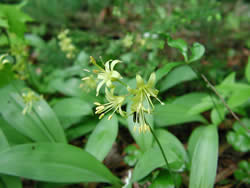USDA Forest Service Celebrating Wildflowers
|
|
|
Plant of the Week
Bluebead lily (Clintonia borealis (Ait.) Raf.)Bluebead lily or yellow clintonia as it is sometimes known is a perennial member of the lily family. Residing in the cool acidic forests of northeastern and north central North America it ranges as far south as the mountains of North Carolina. Closely related species also occupy the southern Appalachians, western North America and parts of Asia. Sometimes considered a northern hardwood or boreal species it occurs commonly with Indian cucumber root, red trillium, hobblebush, and striped maple. The common name is a reference to the porcelain blue berries produced in mid to late summer. The plants are colonial in nature; often found in great colonies of medium green, glossy basal leaves. The leaves can reach 12 inches in length, but are more commonly six to eight inches long and are sometimes confused with wild leeks (Allium tricoccum) and several orchid species including pink lady’s-slipper (Cypripedium acaule) and showy orchis (Orchis spectabilis). A close look at the leaves shows the parallel veins typical of all monocots, the group to which lilies belong. Further inspection of the flower reveals a miniaturized version of a Canada lily flower: six yellow petals with flaring petals hanging in clusters of three to eight from atop the flower stalk.
Transitioning from green to white, and ultimately to a deep porcelain blue, the berries of blue-bead lily are perhaps its most striking feature. Standing on stalks ranging from 4 to sometimes 16 inches in height, they stand out in sharp contrast to greens and browns of the forest floor. These blue berries may look appetizing, but they are not blueberries. Although they are not poisonous, they are quite foul tasting and should be avoided. The appreciation of this plant should be in its viewing, not its flavor. For More Information: PLANTS Profile - Clintonia borealis, Bluebead lily |
|
| NOTE: PDF format links require the Adobe Acrobat Reader to view. | |
| top | Disclaimers | FOIA | Privacy Policy | Quality of Information | Photo Credits & Use |
Location: http://www.fs.fed.us/wildflowers/plant-of-the-week/clintonia_borealis.shtml
Last modified: Tuesday, 24-Jun-2008 21:58:26 EDT




